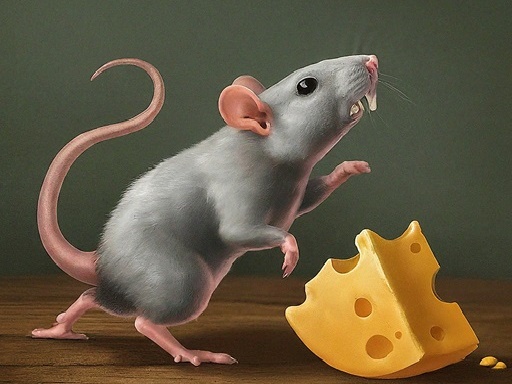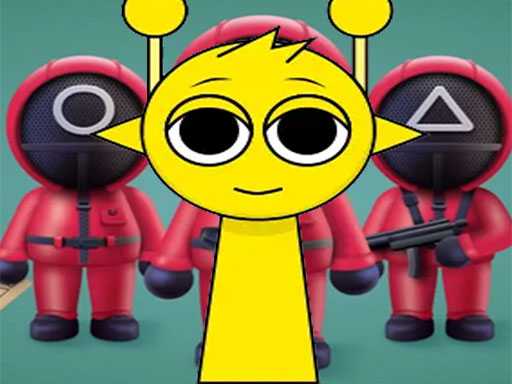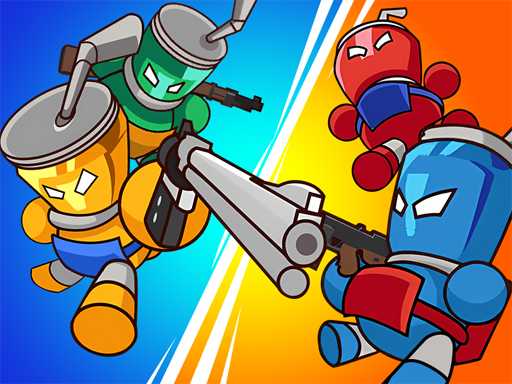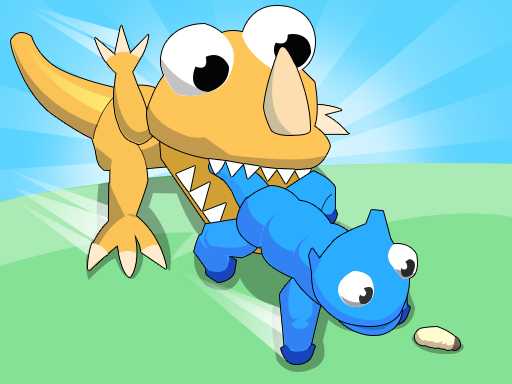
A Chase Worth Cheering For
Have you ever rooted for an underdog so hard that you found yourself leaning toward your screen, whispering, “Run, little guy, run!”? That’s exactly what happens the moment you start playing You Have to Eat Cheese.
You control a tiny rat with an even tinier dream: to snag a piece of cheese before a relentless cat catches up. The premise is simple—almost deceptively so. But oh, what a rollercoaster of reflexes and strategy it becomes.
One click makes the rat jump. That’s it. Click to jump the mouse. No complex buttons, no fancy combos. Yet somehow, the simplicity pulls you in and doesn’t let go. The cat’s eyes gleam with mischievous intent, the cheese gleams like gold, and suddenly, you’re no longer sitting at your desk—you’re sprinting through a labyrinth of near misses and heart-thumping escapes.
There’s something universally lovable about a game that doesn’t try too hard, yet delivers pure adrenaline. It’s like an old-school cartoon mixed with a dash of arcade magic. The moment your rat clears an obstacle by a whisker (pun intended), you can’t help but laugh in triumph.
Now, let’s peek behind the maze walls and see what makes this game such an irresistible sprint between fear and feast.
The Whisker-Thin World of Gameplay
At first glance, You Have to Eat Cheese seems straightforward: run, jump, survive, and snack. But under the surface lies a clever balance of timing, coordination, and anticipation.
The Setting
You’re dropped into a brightly colored maze that shifts and bends as levels progress. Some paths are narrow, others wide; some floors stay still, while others crumble beneath your paws. The design evokes a childlike joy reminiscent of weekend cartoons—but with a pulse-pounding edge.
The Goal
Simple: reach the cheese before the cat catches you, or before time runs out. Each round is a race against two ticking threats—the timer and the predator.
The Controls
-
Click or Tap: Jump over obstacles.
-
Hold Click: Higher jump.
-
Quick Double Click: Short bounce or mid-air correction (unlocks in later levels).
That’s it. The beauty of this control scheme is how intuitive it feels. A five-year-old can play it, but mastering it? That’s a different story.
The first few rounds are forgiving—a few gaps to leap, a wall or two to hop. But as you advance, the maze morphs. Platforms move, the cat grows faster, and your margin for error shrinks. The real thrill lies in learning rhythm. It’s a dance between instinct and calculation, with every click timed like a drumbeat.
Ever noticed how your fingers tense up before a tricky jump, as if your body knows what’s coming? That’s when the game starts speaking your language—the universal tongue of reflex and reaction.
And once you’ve tasted that victory cheese (literally), you’ll crave more. But to survive the tougher levels, you’ll need more than quick clicks. You’ll need strategy.
Strategy à la Cheese: From Scurry to Mastery
Think of You Have to Eat Cheese as a test of micro-decisions. Each jump, hesitation, or overstep determines your fate. To master the maze, you’ll need to plan ahead like a tiny tactical genius.
Let’s break it down with this Cheese Survival Strategy Table:
| Challenge Type | Objective | Smart Strategy | Bonus Tip |
|---|---|---|---|
| Simple Maze | Reach cheese fast | Focus on short hops | Save time for tricky ends |
| Obstacle Rush | Jump over gaps | Time jumps mid-run | Avoid jumping too early |
| Moving Platforms | Sync rhythm | Watch platform patterns | Don’t panic—timing beats speed |
| Cat Chase | Keep distance | Use double jumps wisely | Lead the cat toward dead ends |
| Speed Rounds | Beat timer | Skip optional paths | Focus only on direct routes |
Now, a few golden rules of the maze:
- Never rush the first jump. The game often teases you with an early gap—wait for it.
- Use sound cues. The cat’s footsteps or growls indicate proximity; listen carefully.
- Cheese isn’t always straight ahead. Some levels hide it behind vertical routes—explore smartly.
- Momentum is everything. Once you stop, it’s hard to restart under pressure.
Mini-dialogue moment:
“Wait… did the cheese just move?”
“Yup, welcome to Level 8. It’s got legs now.”
“Oh great, now I’m chasing dinner instead of eating it.”
That’s part of the fun—each level adds a cheeky twist that keeps you on your toes (or paws).
But here’s the twist: this game isn’t just about speed. It’s also about mindset.
The Zen of Cheese: Timing, Patience, and Panic
What makes You Have to Eat Cheese so oddly addictive is its delicate balance between panic and patience. It teaches you, almost subconsciously, when to act and when to wait.
Timing Is Everything
A beginner clicks frantically, hoping speed equals success. A seasoned player? They listen to the rhythm of the maze. They wait for that perfect heartbeat between obstacle and opportunity.
Have you ever noticed how games like this mirror real life? Sometimes charging ahead only gets you caught; sometimes pausing for half a second changes everything.
The Psychology of the Chase
The cat isn’t just a digital enemy—it’s a representation of pressure. It’s deadlines, expectations, chaos—all chasing you toward your “cheese.” Learning to stay calm as it closes in? That’s emotional intelligence, in 8-bit form.
Even children start developing a sense of controlled response here. According to Khan Academy’s studies on cognitive skill development, timing-based games strengthen working memory and response control—skills vital for focus and emotional balance.
So yes, You Have to Eat Cheese is not just a game. It’s a tiny mindfulness exercise dressed as a cartoon chase.
And speaking of mindfulness—let’s zoom out and look at how this game engages players of all ages, from kids to parents to casual gamers.
One Maze, Many Players: Fun for All Generations
One of the best things about You Have to Eat Cheese is how it bridges the generational gap. It’s simple enough for a child, nostalgic enough for adults, and competitive enough for teens.
For Kids: Learning Through Laughter
Kids adore the silly visuals—the plump cat, the squeaky sounds, the cheese that sparkles like treasure. But beneath that humor, the game hones spatial reasoning and pattern prediction.
“Mom, did you see that? I jumped right before the cat pounced!”
“See? You’re learning timing, buddy.”
It’s playful learning at its best. And because the game rewards persistence, children pick up a subtle but powerful message: every mistake is a lesson.
For Parents: Nostalgia with a Dash of Calm
Parents often find themselves stealing a few rounds after bedtime. Why? Because it’s comforting. The simplicity is refreshing—a throwback to classic platformers from the ’90s, but smoother, brighter, and more forgiving.
It’s also oddly meditative. The repetitive rhythm of jumps and near misses creates a loop that soothes the mind, almost like breathing exercises.
For Gamers: Strategy in Speed
Casual gamers appreciate how You Have to Eat Cheese escalates. What starts as easy fun soon becomes a tactical sprint. You’ll start memorizing jump patterns, optimizing click intervals, and analyzing how the cat reacts to your movements.
And when you finally beat that brutal level where the cheese hides behind three moving traps? Pure euphoria.
Everyone plays for different reasons—but everyone walks away smiling.
Now, let’s lace up our tiny sneakers and talk about something universal: the art of improvement.
From Panic to Precision: Leveling Up
Once you’ve survived your first few levels, you’ll start seeing patterns—the way obstacles sync, the rhythm of your jumps, even how the cat behaves. That’s when You Have to Eat Cheese evolves from simple reflex fun to something much more strategic.
Step-by-Step Skill Building
- Observe Before You Jump. Take two seconds to study obstacle timing. Early patience equals long-term speed.
- Master the Small Jump. Over-jumping wastes time and messes rhythm; short hops keep you stable.
- Use Corners for Cat Control. Lure the cat toward narrow turns—it slows down on corners.
- Memorize Maze Layouts. Each new level repeats patterns from earlier ones in clever disguises.
- Train Your Reaction Loop. Try quick practice rounds focusing solely on timing, not cheese collection.
Mini anecdote:
I once replayed Level 12 twenty times, trying to perfect a double jump sequence over spinning blocks. Every time, the cat would almost get me. But when I finally nailed it—barely scraping past its claws—it felt like winning a marathon made of adrenaline and cheddar.
Staying Motivated
Games like this thrive on micro-victories. Every cleared obstacle is a small win. Every near-miss becomes a story.
The lesson? Improvement comes not from perfection, but from persistence.
And while we’re talking about persistence, let’s address the elephant—or should I say, cat—in the room: failure.
When the Cat Catches You
It happens to everyone. You misclick, the rat stalls, and the cat leaps in with a triumphant mrow. Game over.
But failure in You Have to Eat Cheese isn’t punishing—it’s instructive. The moment you lose, you instantly see what went wrong. Maybe you jumped too soon. Maybe you hesitated. Each defeat becomes a teacher.
In fact, the game’s restart system is designed to keep you engaged. No long loading screens, no guilt trips. Just a quick reset and another chance to run.
“Okay, one more try.”
(Twenty minutes later…)
“Okay, just one more try.”
Sound familiar? That’s the magic loop—instant feedback paired with humor. It keeps frustration from turning into quitting.
And if you’re playing with kids, it’s the perfect moment to teach resilience: “See? Even when the cat wins, we learn something new.”
Now that we’ve faced the feline, let’s talk about how to turn your victories into mastery—and maybe even mindfulness.
The Flow of Focus
There’s a moment, mid-run, when you stop thinking and start flowing. Your clicks sync perfectly with the maze. Obstacles seem to move in slow motion. You’re not reacting anymore—you’re predicting. That’s “flow state,” the holy grail of gaming.
Psychologists describe flow as a state of full immersion—when skill meets challenge at just the right level. You Have to Eat Cheese nails this balance beautifully. The levels never feel unfair, only enticingly difficult.
And this state isn’t just fun—it’s healthy. Studies from the American Psychological Association suggest that games promoting flow improve focus, patience, and emotional regulation.
So the next time someone says you’re “just playing a mouse game,” you can proudly reply, “Actually, I’m sharpening my cognitive precision.”
Now let’s sprinkle in something all good games need—community and connection.
Shared Cheese: Playing Together
You’d be surprised how social a single-player chase game can be. Families take turns, comparing who survived longest. Friends challenge each other to “beat Level 10 without missing a jump.” Even online forums buzz with players sharing screenshots of their best runs.
Playing side-by-side adds laughter and camaraderie. You’ll cheer when someone clears a tough stage and groan when the cat pounces at the last second.
Some families even create small reward systems—every time someone beats a level, they earn a “cheese coin.” Ten coins? Pizza night!
That sense of shared progress turns a simple digital maze into a living-room adventure.
And when you think about it, that’s what gaming is supposed to be—shared joy, not just solitary escape.
Now, before we wrap up this tale of tails, let’s recap everything you need to know to truly master the maze.
Quick Recap: The Rat’s Rulebook
- 🧀 Click to jump, hold to soar. Timing is king.
- 🕒 Watch the clock. Every second counts—don’t overthink.
- 🐱 Use the cat’s movement. Corners and pauses are your allies.
- 💨 Flow over force. Smooth rhythm beats frantic clicking.
- 🔁 Embrace retries. Each loss is a map to your next win.
It’s fast, it’s frantic, and it’s surprisingly wise beneath the fur and fun.
Final Bite
At its core, You Have to Eat Cheese is more than a quick reflex game—it’s a charming little metaphor for life. We all chase our cheese. We all dodge our cats. And sometimes, we fall into holes before finding our rhythm again.
The game doesn’t just entertain; it reminds us that persistence, timing, and humor can turn any chase—digital or real—into something joyful.
So the next time you hear that mischievous cat closing in, don’t panic. Take a breath. Jump smart. Laugh when you miss. Then start again.
Because, in the end, victory always tastes better with a little cheese. 🧀✨
For Your Social
📸 Show off your best runs, your funniest cat chases, and your victorious cheese grabs! Use these hashtags and tag your fellow players:
#YouHaveToEatCheese #CheeseChaser #MouseVsCat #PuzzleGaming #FamilyFun #MindfulPlay






